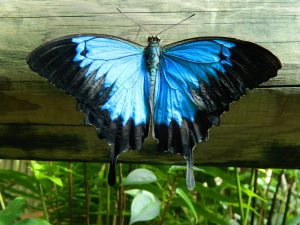Ever wondered about butterfly senses?
When you come to the visit us at the Australian Butterfly Sanctuary, try to get a good look at a butterfly’s head.
It’s dominated by two large round eyes and two long antennae with club tips. On a big butterfly like the Cairns Birdwing, you will also be able to see the proboscis which is the mouth part, coiled under the head. On smaller butterflies this is not so noticeable, as the proboscis is smaller
Butterflies have excellent sensory capacity. They have compound eyes like flies and can see 314 degrees around themselves, although they don’t have clarity or sharp vision.
Did you know butterflies see more colour than we do? We see from the red spectrum to violet, whereas they see from red to ultraviolet. This is very useful when looking for flowers to drink nectar, as flowers fluoresce in the ultraviolet spectrum. This can also help with mate recognition as some butterflies have ultraviolet markings on their wings.
Butterflies don’t have a nose or ears like we do but their antenna have senses that detect vibrations from sounds and air movement. They can also detect chemical signals we know as smells.
Antenna are also used for touch when socialising with the opposite sex.
The antenna can be used like a GPS for locating food plants and with male moths for locating females. Sensors on the antenna detect pheromones and food plants for the caterpillars, and bounce the signal from each antenna together which creates a triangle. This points them in the direction they need to fly.
Butterflies also have chemical receptors on their feet that allow them to taste the plants they land on. This gives them the ability to recognize the correct food plant for their caterpillars.
Butterflies are very sensitive creatures!






